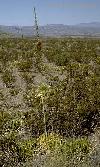| Plant Photo |
Scientific Name |
Common Name and Description |
Seed Photo |
 |
Agave lechuguilla |
Common Name: Agave
Leaves: 3.5 dm long and 2-3 cm wide, linear, straight to falcate (sickle-shaped) or upcurving
Flowers: In clusters of 1-3, ovary greenish-yellow, fusiform (spindle-shaped - thickest near the middle and tapering toward each end), 12-14 mm long, tepals 12-18 mm long, spreading, linear, yellow to red or purplish
Fruit: Capsules oblong, 2-3 cm long
Habitat: Open arid calcareous rocky slopes
Range: West Texas, southern New Mexico, southeast across the Mexican highlands to State of Mexico
Group: Monocot
Family: Agavaceae
Growth Habit: Subshrub/Shrub/Forb/Herb - small widely suckering yellow-green rosettes 2.5-4 dm tall
Duration: Perennial
U.S. Nativity: Native |
 |
 |
Yucca baccata |
Common Name: Banana Yucca, Blue Yucca or Datil
Leaves: Broadened toward the middle, commonly straight or incurved, occasionally twisted, rather deeply concavo-convex, quite rigid, 3-7 dm long and 3.5-5 cm wide
Flowers: Campanulate (bell-shaped), pendent, white or cream-colored, commonly tinged with purple
Fruit: 7-24 cm long 25-55 mm in diameter, symmetrical, broadly cylindrical or somewhat tapering; seeds to 11 mm flat, thick, rough, dull black
Habitat: On rocky hill and mountain slopes and plains of grasslands, juniper and oak woodlands
Range: West Edwards Plateau and Trans-Pecos, Texas to California and adjacent Mexico
Group: Monocot
Family: Agavaceae
Growth Habit: Subshrub/Shrub/Forb/Herb - clumped at ground level 1-5 m in diameter, with as many as 70 heads of leaves
Duration: Perennial
U.S. Nativity: Native |
 |
 |
Echinocereus enneacanthus |
Common Name: Hedgehog Cactus or Pitaya
Leaves: Not discernible, 1-4 central spines per areole, 25-94 mm long; 7-10 radial spines
Flowers: On the old growth below the apex of the stem, bursting through the epidermis just abouve the spine-bearing areole; 7.5-12.5 cm in diameter
Fruit: Red flesh with deciduous areoles bearing spines, has a fragrant odor and a flavor and texture resembling the strawberry; black seeds strongly tuberculate (covered with tubercles) to pitted, 1-1.4 mm long
Habitat: Dry, sandy soils
Range: Val Verde to Kimble, Kerr and Cameron counties; also Chihuahua and Tamalupas
Group: Dicot
Family: Cactaceae
Growth Habit: Shrub/Subshrub - stems profusely branching with 120-350 forming clumps up to several dm high and 6-20 dm in diameter; stems cylindroidal
Duration: Perennial
U.S. Nativity: Native |
 |
 |
Opuntia Lindheimeri engelmannii |
Common Name: Texas Prickly Pear or Nopal Prickly Pear
Leaves: Spines in all but the lower areoles, 1-6 per areole
Flowers: 5-7.5 cm in diameter; petaloid perianth parts yellow
Fruit: Purple, fleshy, obovate or elongate 3.1-7 cm long
Habitat: On rocky hill and mountain slopes
Range: Texas, New Mexico and Mexico
Group: Dicot
Family: Cactaceae
Growth Habit: Shrub/Subshrub - 1 to 3 m high joints green or blue-green, obovate to orbiculate or rarely elongate, 15-25 cm long
Duration: Perennial
U.S. Nativity: Native |
 |
 |
Opuntia leptocaulis |
Common Name: Tasajillo, Christmas Cactus or Pencil Cholla
Leaves: Spines 1 per areole, 2.5-5 cm long
Flowers: Flower 1-1.5 cm in diameter; petaloid perianth parts green to yellow or bronze
Fruit: Bright red, fleshy, juicy, tuberculate, obovoid, 2 cm long
Habitat: Rocky soils of desert hillsides
Range: Southern New Mexico to Texas west of the Pecos River
Group: Dicot
Family: Cactaceae
Growth Habit: Shrub/Subshrub - small with joints of the main branches to 3-4 dm long; cylindroidal; tubercles almost lacking
Duration: Perennial
U.S. Nativity: Native |
 |

